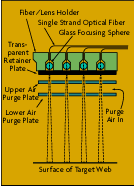Fiber Applications
A sapphire probe developed by Accufiber has the sensing end coated by a refractory metal forming a blackbody cavity. The thin, sapphire rod thermally insulates and connects to an optical fiber as is shown in Figure 5-2. An optical interference filter and photodetector determines the wavelength and hence temperature.
Babcock & Wilcox has developed a quite useful moving web or roller temperature monitoring system which will measure temperatures from 120°C to 180°C across webs up to 4 meters (13 ft.) wide (Figure 5-3). The system combines optical and electronic multiplexing and can have as many as 160 individual pickup fibers arranged in up to 10 rows. The fibers transfer the radiation through a lens onto a photodiode array.
Fiber optic thermometers have proven invaluable in measuring temperatures in basic metals and glass productions as well as in the initial hot forming processes for such materials. Boiler burner flames and tube temperatures as well as critical turbine areas are typical applications in power generation operations. Rolling lines in steel and other fabricated metal plants also pose harsh conditions which are well handled by fiber optics.
Typical applications include furnaces of all sorts, sintering operations, ovens and kilns. Automated welding, brazing and annealing equipment often generate large electrical fields which can disturb conventional sensors.
High temperature processing operations in cement, refractory and chemical industries often use fiber optic temperature sensing. At somewhat lesser temperatures, plastics processing, paper making and food processing operations are making more use of the technology. Fiber optics are also used in fusion, sputtering, and crystal growth processes in the semiconductor industry.
Beyond direct radiant energy collection or two-color methods, fiber optic glasses can be doped to serve directly as radiation emitters at hot spots so that the fiber optics serve as both the sensor and the media. Westinghouse has developed such an approach for distributed temperature monitoring in nuclear reactors. A similar approach can be used for fire detection around turbines or jet engines. Internal "hot spot" reflecting circuitry has been incorporated to determine the location of the hot area.
An activated temperature measuring system involves a sensing head containing a luminescing phosphor attached at the tip of an optical fiber (Figure 5-1). A pulsed light source from the instrument package excites the phosphor to luminescence and the decay rate of the luminescence is dependent on the temperature. These methods work well for non-glowing, but hot surfaces below about 400°C.

Figure 5-2: Typical IR Fiber Optic Probe

Figure 5-3: Multipoint
Pick-up Assembly